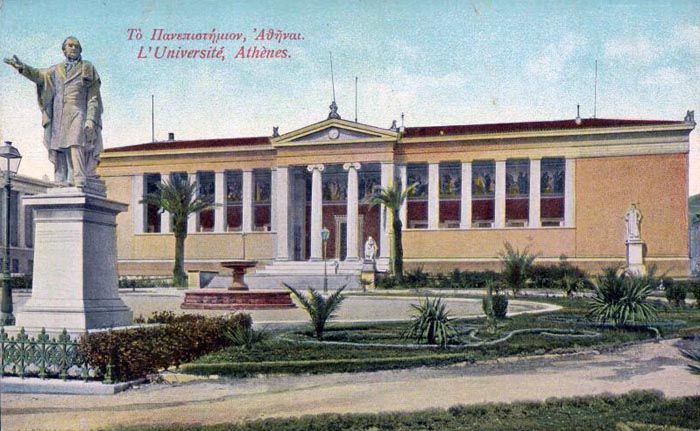Nikos Zias, Professor at the Faculty of Philosophy of the University of Athens
Man is the chief subject of paintings by Father Stamatis Skliris—man in his two aspects: redeemed and deified through grace, bathed in divine light, and at the same time confined by his own isolation and his quests.
His painting has its origin in religious art, one part of his work persisting in this sphere, for it is in it that man achieves his fulfillment. But even the other part is not unconnected with the “theological” concept of painting. Redemption, transfiguration, and final deification through grace are the privilege not only of bygone times but also of every age, including of course the present one. So it is that Father Stamatis' painting speaks of contemporary man, though in a painterly language which makes communication possible with the world of grace and the light of the Transfiguration. Thus in one series of pictures, painted mostly in Paris, we see a head or a human figure cooped in cramped garrets, sometimes portrayed as small pedimented structures, and the hair of intense red or auburn color, the large eyes full of anguish or the gesture empty of hope, reaching out to communicate with those outside.
The draughtsmanship is unrestrained, the lessons of Byzantine delineation taken to heart, but it possesses a pronounced expressiveness that comes close to contemporary visual conceptions. The color harmonies and especially the modelling are more immediately associated with portraiture as it was practiced in Hellenistic times and is known to us from surviving evidence of the Greco-Roman tradition. The modelling of the face is achieved with a combination and juxtaposition of warm and cool colors, the cheek bones and forehead, for instance, being picked out in pale rose while greenish hues denote the shadows around the edges of the cheeks and a profusion of intermediate tints softens the tonal contrasts. Such modelling, here more free, there more controlled, is typical of facial features in Fayum as well as Byzantine and post-Byzantine portraits (current excavations are discovering comparable portraits of even earlier date, of the time of Alexander the Great). A further characteristic is the large dreamy eyes with their sour look of interrogation and indeterminate air of inquiry. The hair streaming in the wind and painted with a multiplicity of tiny brushstrokes gives a faint echo of impressionist art; it stresses the dreamlike mood and suggests a sense of flight, emphasized by the occasional use of collage with sections of maps.
In some instances the portraits are of a robust and heroic nature. Saint Joan of Arc, her face depicted in a contemporary but schematic manner, is attired in burnished armor while her virginal figure is lost beneath this painterly interpretation, much as in portrayals of post-Byzantine saints.
A red-haired military figure of another time and place, with full features and a strong jaw, is reminiscent of worldly, but also slightly other-worldly, works by Photis Kontoglou. The idiom, however, differs as regards both the drawing and the color harmony.
In his depictions of saints, which are also a kind of portraiture though with the additional element of transfigured facial features, Father Stamatis attempts to render transfiguration in a painterly way that does not entail the loss of identifying characteristics. In his “Saint John the Baptist”, “greatest among the earth-born”, for instance, the human element, with the toughness implicit in frontal portrayal, is particularly obvious. The tender mirthfulness on the face of the Greco-Italian saint, Elias the Younger of Sicily, with his heavy, almost slate-grey beard and the sparse warm highlights in the molding of the figure, conveys the glad-sad nature (charmolypi) of the holy man. Father Stamatis’ work is permeated by recollections of the chromatic scale and the mas¬sive modelling of 14th-century Macedonian and Serbian painting. Another of his paintings which has to do with the life of Saint Elias is a seascape, one of the few works he has executed without a human figure in them. The red ship on a storm-lashed sea alludes to one of the saint’s many adventurous travels.
The artist invents a personal idiom, taking account of the lessons to be learnt from Byzantine perspective in representing the land that appears in his seascape, from folk art draughtsmanship in depicting the ship, and from a form of naturalism in rendering the sea which nonetheless assumes a character beyond the bounds of realism as it mounts up and becomes one with the sky.
In some of his pictures—for example in the ones whose subject matter is the life of Prophet Elijah—he endeavors to create new iconographic compositions, while in others he introduces highly detailed variations into estab¬lished iconographic prototypes—for instance when rendering the features of the individuals he portrays, as in his “Resurrection”, and to an even greater extent in his chromatic scale. In a few cases though, of which his “Panaghia Glykophiloussa” is an example, he remains faithful to prototypes, disclosing his thorough knowledge of the technique involved.
Father Stamatis’ art germinates and grows in the fertile soil of tradition. Simultaneously he tries his hand at modern figurative experimentation, but only in so far as he considers it admissible in his work. His painting is dynamic and at times perhaps uneven. But it is full of a vitality that reveals a painter vigilant by nature, and that is of particular importance in the world which he serves.
From: Père Stamatis Skliris, Itinèraire Pictural, Edition Akritas, 1994

